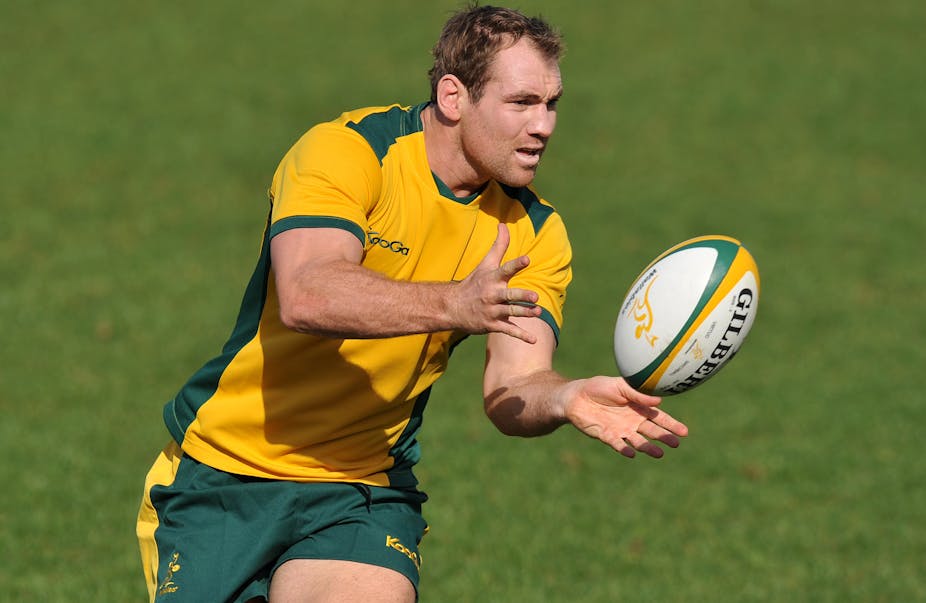RUGBY WORLD CUP – As New Zealand gets World Cup fever, James Cook University’s Chris Davies discusses where rugby union’s place in the Australian sporting landscape.
It’s on again – we’re now four weeks into the Rugby World Cup in New Zealand.
Australia, as the number two ranked team in the world, and the present Tri-Nations champions, began the cup as one of the tournament favourites.
But where does rugby union fit into Australian sport? And where is it heading?
Origins
Rugby union evolved from the village football games that were played in England. It differed from other games because players were allowed to handle and carry the ball.
The Rugby Football Union was formed in England in 1871, and the game quickly spread to the colonies, including Australia. In fact, international rugby has been played since the early 1880s.
A formal amateur Sydney club competition was established in 1900. But some clubs broke away in 1908 over the issue of injury compensation for players.
In the 1970s and 80s amateur rugby union lost many players to professional rugby league, including players such as Russell Fairfax, Michael O’Connor, Ray Price and Ricky Stuart.
Things changed in 1995 when rugby union turned professional, and the exchange of players began to go the other way, with the likes of Wendell Sailor, Lote Tiquiri and Mat Rogers switching from rugby league to rugby union.
Four codes, fierce competition
Players swapping between the codes highlights the fierce competition that exists within the relatively small Australian sporting market.
This level of competition doesn’t only relate to players, but also for spectators and sponsorship.
After all, Australia is the only country in the world with four professional football codes. So rugby union is not only in competition with rugby league, but also Australian rules football and soccer.
Where is rugby union headed?
It is suggested that the four football codes played in Australia all have their strengths and weaknesses, both in regard to the rules of the sport itself, and also their share of the market.
At its best, there is no doubt that rugby union is a free-flowing game, but it is also very technical which means there are often a lot of penalties. This means it can be hard to follow for those who do not fully understand the rules.
Within Australia, it is also hampered by the fact that the sport must comply with the rules set by the International Rugby Board (IRB) which may not always best fit in the Australian context.
This is in sharp contrast to the Australian Football League (AFL), for instance, which can make its own decisions in regard to rule changes to help make the game more appealing to spectators.
Rugby on the world stage
Yet it is also this international aspect of rugby union that is a strength as well as weakness.
Only soccer has a bigger world game, and the Rugby World Cup, held every four years since 1987, is undoubtedly a major international sporting event.
The internationals are important for revenue for the Australian Rugby Union (ARU). Unlike the AFL and rugby league, much of its revenue comes from the national matches, rather than the domestic club competitions.
Thus, while the ARU does have a good overall revenue base, it is also dependent to a large degree on the performance of the national team which is why Australian performance in this year’s Rugby World Cup will be important for the ARU’s bottom line for years to come.
There is also no doubt that the lure of playing international rugby union helps to attract and retain young players.
Professionalisation
But one of the outcomes of the sport turning professional in 1995 was the establishment of a competition between provincial and state-based franchises in Australia, New Zealand and South Africa, known today as the Super 15.
This not only enabled Australia to have a professional state-based teams, but also to establish teams outside its traditional NSW and Queensland stronghold.
At a time when all four football codes see expansion as an important aspect of long-term viability, this was a major plus for rugby union.
The most recent addition has been the Melbourne Rebels, which in its inaugural 2011 season managed to have average crowds 30-40% larger than that of the Victorian based rugby league team, the Melbourne Storm.
Rugby union here to stay
Rugby union has been a significant sport in Australia for well over a hundred years and it is likely it will at least retain its present market share within Australian sport.
The recent addition of both Perth and Melbourne based Super 15 teams meanwhile provides a possible means of expanding on its present share.
The other X factor rugby union has is the potential of its national side to win the prestigious Rugby World Cup, and there is no doubt such a win would increase the profile of the sport in the short to medium term.
This is the fifth part of our Rugby World Cup series. To read the other parts, follow these links:
- Part one: Rugby World Cup: All Blacks, New Zealand Maori and the politics of the pitch
- Part two: What will the Rugby World Cup be worth to New Zealand
- Part three: Art or science? Decision making in rugby
- Part four: Rugby World Cup: Are cheats prospering?
- Part five: Rugby World Cup: The Australian situation
- Part six: Selling the Rugby World Cup
- Part seven: Rugby World Cup injuries: That’s gotta hurt
- Part eight: Rugby World Cup a lottery amid refereeing chaos
- Part nine: All Blacks’ proud tradition of the haka insulted in Rugby World Cup

